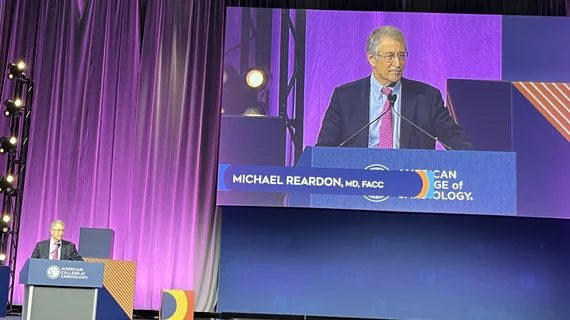So far, so good: TAVR comparable to open heart surgery after 5 years in low-risk patients
New five-year data suggest transcatheter aortic valve replacement (TAVR) with a supra-annular, self-expanding valve is a safe and effective alternative to surgical aortic valve replacement (SAVR) when treating low-risk patients. In fact, hemodynamic data after five years consistently favors a transcatheter approach.
That’s all according to a late-breaking clinical trial presented at ACC.25, the annual conference of the American College of Cardiology.
Michael J. Reardon, MD, professor and Allison Family Distinguished Chair of Cardiovascular Research at Houston Methodist Hospital, presented five-year findings from the Evolut Low Risk trial in front of a large audience for what was arguably the most highly anticipated presentation of the entire conference. The trial randomized more than 1,400 low-risk aortic valve replacement patients to undergo either TAVR or SAVR. All TAVR patients received a supra-annular, self-expanding Evolut valve from Medtronic. Patients underwent treatment at one of 86 facilities around the world. The mean age was 74 years old, and 35% of patients were women.
The Evolut Low Risk Trial has received significant attention since it launched, and Reardon presented four-year findings at TCT 2023 in San Francisco. What did the data show in this latest update?
Exploring the five-year data
Follow-up data was available for 91% of TAVR patients and 87.4% of SAVR patients who participated in the Evolut Low Risk Trial. Overall, the primary endpoint of all-cause mortality or disabling stroke was seen in 15.5% of TAVR patients and 16.4% of SAVR patients. The rates of all-cause mortality and disabling stroke were also comparable on their own, as were rates of aortic valve hospitalization and total valve thrombosis.
The data did reveal certain differences between the two techniques. New permanent pacemakers were much more common after TAVR (27% vs. 11.3%), for example, while atrial fibrillation was much less frequent after TAVR (16.3% vs. 41.2%).
From a hemodynamic perspective, meanwhile, TAVR patients were associated with superior mean gradients and mean effective orifice areas compared to SAVR.
One takeaway from the presentation was the fact that all-cause mortality did appear to increase for TAVR between years four and five after following a steady pattern for the first four years. This was largely because multiple patients who had a disabling stroke earlier in the trial went on to die in the study’s final months, Reardon explained. COVID-19 was also associated with some patient deaths, he added, which contributed to that rise in all-cause mortality.
Another key point from the presentation was the fact that both TAVR and SAVR were associated with high Kansas City Cardiomyopathy Questionnaire scores after five years.
“Both of these [treatment options] keep you alive and make you feel better,” Reardon said.
He then offered his final conclusions to the audience, noting that TAVR with a supra-annular, self-expanding Evolut valve from Medtronic appears to be a “safe, effective and durable alternative to surgery for patients with severe aortic stenosis and low surgical risks.”
The full study was published in the Journal of the American College of Cardiology.[1] Click here to review the team’s analysis.
TAVR tech keeps evolving
ACC.25 panelist Juan F. Granada, MD, president and CEO of the Cardiovascular Research Foundation, asked Reardon what could potentially help keep the relatively high pacemaker and paravalvular leak rates seen in this study down in the future.
Reardon noted that Medtronic’s Evolut valve technology has already evolved since the patients in this trial were initially treated, pointing to the cusp overlap technique and improvements in coronary access as two major examples.
Related commentary: 10-year data on low-risk patients will tell full story
The five-year Evolut Low Risk update made a substantial splash at ACC.25. According to a new editorial published in the Journal of the American College of Cardiology, however, clinicians will not fully understand the long-term safety and effectiveness of these techniques until 10-year data are available.[2]
First author Tsuyoshi Kaneko, MD, a cardiothoracic surgery specialist with Washington University School of Medicine, wrote the editorial with three cardiologist colleagues.
The group put these latest data into context by evaluating midterm results from two additional randomized controlled trials focused on low-risk patients: the PARTNER 3 trial, which compared TAVR with balloon-expandable valves to SAVR, and the NOTION trial, which compared TAVR with an early self-expanding valve to SAVR.
“Combined with the five-year results of the balloon-expandable valve and NOTION trial results, showing noninferiority of TAVR compared with SAVR, this study further reinforces the safety and efficacy of TAVR for low-risk patients with aortic stenosis at five years,” the authors wrote. “The data also somewhat dispel previous concerns, such as the impact of valve hemodynamics and mild paravalvular leak on outcomes, valve durability, valve thrombosis and valve reinterventions. It was shown that at five years, mild paravalvular leak did not affect survival, and there were no significant differences between TAVR and SAVR in terms of valve durability, valve thrombosis and valve reinterventions. However, several key questions remain, especially with the concept of lifetime management of aortic stenosis permeating throughout our specialty.”
One of the group’s primary questions about these data was related to the observed rise in mortality.
“Most of the mortality in the TAVR arm was from noncardiovascular death; nevertheless, when it is amalgamated with the mortality curve crossing in the PARTNER 3 trial at five years, close observation of the future long-term results of these trials with minimization of loss to follow-up will be imperative,” they wrote.
Kaneko and colleagues also highlighted the fact that many different categories of low-risk patients were excluded from Evolut Low Risk. This included patients with bicuspid valve, multivalvular disease, complex coronary disease and high-risk anatomies.
“Overall, this could represent close to 50% of the low-risk patients who are referred for aortic valve intervention,” they wrote.
For now, the editorial’s authors remain focused on the long-term data that are still to come.
“Although the five-year result of this trial provides compelling evidence with no significant negative signal against TAVR in terms of the main clinical outcomes and valve performance, our journey to understanding the lifetime management of aortic stenosis is still at its dawn,” the group concluded. “It is an exciting time in our field to navigate aortic valve interventions, especially in younger low-risk patients, and we will further await the long-term outcome of Evolut Low-Risk and PARTNER 3 because both trials are scheduled for a 10-year follow-up.”
Click here for the full editorial.
Medtronic shares its perspective
For Medtronic, the new data represent major progress after following these low-risk patients for five years. Going into ACC.25, the company had shared its excitement about the presentation.
“These results reinforce the recently reported Evolut evidence from the SMART trial, which emphasized superior hemodynamics and lower rates of valve dysfunction,” Kendra J. Grubb, MD, vice president and chief medical officer of Medtronic’s structural heart division, said in a statement. “The Evolut Low Risk data presented today will help clinicians make personalized treatment decisions for younger, lower-risk patients by considering each patient's unique needs, now acknowledging that data supports TAVR with Evolut as a safe and durable alternative to surgery.”

